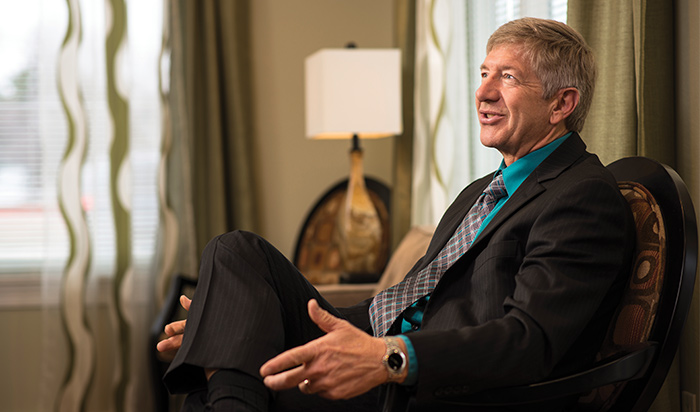Running a healthy practice
Running a healthy practice

Mark Miehe, CFP, CLU, CHFC • Madison, WI
Midwest Financial Group, Inc. • SII Investments, Inc.
Whether a 200-mile team road race or his family’s Wisconsin dairy farm, Mark Miehe has shown he can run it well. So it comes as no surprise that his financial-planning firm, Midwest Financial Group, Inc., continues on a track of healthy growth.
Proactive Advisor Magazine: Thanks for sitting down with us and sharing your thoughts on active investment management.
You’re more than welcome. It is a pleasure.
What is your focus day to day?
We work with a broad mix of people and don’t really have an account minimum; we look to our longer-term and most-involved clients for referrals to try to duplicate that type of client. Our model is a very efficient business in the way we run our operations, so a relatively smaller client account still receives a high level of service and sophisticated products, especially in the area of active investment management.
We have, I believe, one of the best broker-dealers in the business, SII Investments, Inc. They are advanced in their technology and allow us to work very efficiently as far as the administration of our accounts. They also have a broad roster of third-party money managers, as well as their own management services. So, they have the technology, the service, the products, and the culture—all are top-notch.

What is your planning and investment philosophy from a big-picture perspective?
First of all, we want to have a very strong personal and trusting relationships with clients—talking a lot about values and what people want out of their lives, both now and when they are retired.
As an independent firm, we have always been able to objectively analyze one’s situation and provide sound recommendations. We want to know what’s most important to our clients and then help align financial resources with their personal values and goals. We’ve succeeded when our clients tell us the process has truly helped them improve the quality of their lives.
How do you develop a formal risk profile for clients?
First, assessing short-term, intermediate, and long-term goals. Then we can map out the best route to help clients get there. While there are a lot of sophisticated instruments and questionnaires to get at a risk assessment, we think consulting with clients on all aspects of their financial life is truly the best way.
“To me, it all fits together with our focus on our clients’ quality of life.”
How is that implemented from an investment perspective?
We then go out and match a specific client with the appropriate financial and investment options. There are thousands of different active money managers and mutual funds, and different ways to do things. A major part of my job is to stay current on developments in today’s investment world and to be able to do the due diligence, to monitor that.
I believe in active investment management, using the expertise and analyses of dedicated investment professionals to construct portfolios that have the flexibility to change through different economic and market conditions.
My job is to help determine the appropriate strategy, or more likely, combinations of strategies, that can deliver successful outcomes through all different market cycles. The money managers that we utilize have the ability to make changes—sometimes slight changes, sometimes very significant changes. They can go to cash, go inverse the market, or be leveraged and work across a variety of asset classes.
Those strategies can at times be aggressive, especially with the use of leverage. But we also recommend strategies that would be more in the area of overweighting/underweighting types of strategies. With the overweighting/underweighting, generally the idea is that your returns are going to follow the market a bit more closely. And the objective is that when things are trending positively, to capture a fair portion of the upside and then protect a little bit more on the downside … without being exposed to potential market extremes.
Over the last few years we have seen both sides of the market: a severe crash and then powerful bull market. How have you handled these scenarios with clients?
With the combination of actively managed strategies that are available, we can have a pretty good idea of how a portfolio will react through different market conditions. So, I always reinforce with clients how the actively managed program is put together and its objectives.
For example, if the market’s up over 30%, I tell clients that their account is not likely to be up 30%. However, it may still generate strong returns, though not as high as those of the market. The reason for that is because it’s strategically allocated and managed to control risk.
On the flip side, if the market is down over 20%-30%, risk-managed accounts should not approach those kinds of portfolio losses, either. With this type of strategic allocation, it is all about managing the extremes, setting expectations with clients, and then performing within those expectations.
How do clients react to that approach?
To me, it all fits together with our focus on our clients’ quality of life. One of the most critical issues we see over and over is clients getting too conservative with their investments. The biggest risk at retirement is not in losing your money because the market goes down, but losing your purchasing power because you are too conservative.
With active management, we can add a level of risk management that otherwise might not exist for clients’ investment portfolios, understanding there are never any guarantees. But we see that clients who might have been panicky about market downturns in the past have a higher level of comfort and a willingness to stick with a disciplined approach.

How did you get started in the business in the first place?
I grew up on a dairy farm in southwestern Wisconsin and decided to pursue a degree in agricultural economics at the University of Wisconsin. I worked as a loan officer for a short period of time and then ended up running my family’s dairy farm for a number of years.
But after some time doing that, I decided I really wanted to take advantage of my business and economics background—entering the financial-services industry seemed like an excellent fit. I tell my clients, however, that running that farm taught me the value of hard work and sound business principles. I have a lot of fond memories and keep a picture in my office of the farm.
Lastly, what do you like to do with your down time?
I stay active to keep myself healthy, and I believe activity—active management—will keep my clients’ portfolios healthy as well.
I was a college distance runner for UW-Madison. I still run; it’s my solitude. I still compete, too, both individually and with a group of 12 people for 200-mile relays. Every year we run an event somewhere in the United States—Wisconsin to Minnesota, Canada to Seattle, Oregon mountains to the coast.
Thanks, Mark. Any final thoughts?
Really, it is all about answering one key question for most investors: How can we help achieve reasonable inflation-adjusted returns over time while managing risk? I believe through active management we can keep clients in the strategies they need to achieve returns while providing a comfort level that accounts are being professionally managed each and every day.
Disclosure: Securities and advisory services offered through SII Investments, Inc. (SII), member FINRA/SIPC and a registered investment advisor. SII and Midwest Financial Group, Inc., are separate and unrelated companies.
Photography by Nick Berard

